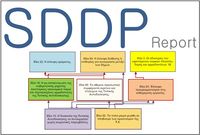Insafe SDDP: Mobile Operators and Self Regulation - Defining an Action Plan
|
Part of Getting the Best out of our Insafe Network 2007 Co-Laboratories.
Executive Summary
The SDDP co-laboratory ‘Mobile Operators and Self Regulation’ documented here built on experiences already gained through the collection of ideas and responses to questions put to Nodes by the ad-hoc Executive Committee and presented during the
Luxembourg meeting earlier this year as well as the results of the 6-month evaluations (Customer
Satisfaction Surveys) performed by the coordinating node. The co-laboratory was dealing with the topic of what
nodes want from the mobile industry and what leverage can they use to promote this. Participants
explored initiatives and actions that nodes can take in order to the mobile industry to take desired
actions.
The triggering question that was tackled in this co-laboratory was:
What initiatives or actions can Nodes take in order to encourage the mobile industry to take desired actions?
Insafe nodes’ staff described 53 ideas and actions ahead of the co-laboratory and during the dialogue with the entire group. The participants altogether grouped these 53 ideas and actions into five categories based on common attributes among the ideas identified by the Nodes’ staff. These categories were named the following:
- Industry Motivation
- Awareness
- Regulation
- Political Influence
- Nodes
The voting results were used to select factors for the subsequent structuring phase to identify interrelations among the generated obstacles. Participants structured 14 ideas/actions. The 14 ideas/actions were structured within three levels and are related according to the influence they exert on each other. Those ideas/actions that appear lower in the Influence Map, hence are positioned at the root of the tree, i.e. Level III, are more influential in terms of influence than those at higher levels and are the ones to tackle preferentially.
More specifically, six actions had been identified as the influential actions:
- Action #46: Make clear that self-regulation is good for image
- Action #32: Acknowledge the benefits
- Action #20: Have precise ideas of what you want
- Action #4: Stress the public standing of your node,
- Action #19:Demonstrate that you can place issues in themedia
- Action #26: Make clear that youth protection sells
After having participated in the structured dialogue it was expected that:
- Participants would gain a deeper understanding of the complexity of the situation and the interconnections between “ideas”;
- Participants would have the opportunity to understand how the “others” may think or perceive the current situation or envision the “ideal” situation;
- A “voted” consensus between all participants taking part in the co-laboratory would emerge in the “influence tree” as a joint product.
The Facilitation Team of this co-laboratory consisted of: Larry Fergeson, Tonia Loizidou, and Tatjana Taraszow.
Participants
| Name | Country |
|---|---|
| Peter Behrens | Belgium |
| Susanne Boe | Denmark |
| Marjolijn Bonthuis | Netherlands |
| Rita Astridsdotter Brudalen | Norway |
| Anna-Maria Drousiotou | Cyprus |
| Maria Kristin Gylfadottir | Iceland |
| Karl Hopwood | UK |
| Bernhard Jungwirth | Austria |
| Riitta Kauppinen | Finland |
| Luu-Ly Mai | Luxembourg |
| Paola Pendenza | Italy |
| Alicja Puchala | Poland |
| Pascale Recht | Belgium |
| Teemu Ruohonen | Finland |
| José Luis Zatarain | Spain |
